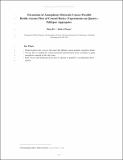| dc.contributor.author | Pec, Matej | |
| dc.contributor.author | Al Nasser, Saleh Mohammed | |
| dc.date.accessioned | 2021-10-27T16:43:08Z | |
| dc.date.available | 2021-10-27T16:43:08Z | |
| dc.date.issued | 2021-05 | |
| dc.date.submitted | 2021-03 | |
| dc.identifier.issn | 2169-9313 | |
| dc.identifier.issn | 2169-9356 | |
| dc.identifier.uri | https://hdl.handle.net/1721.1/133157 | |
| dc.description.abstract | The brittle-viscous transition in the lithosphere occurs in a region where many large earthquakes nucleate. To study this transition, we sheared bimineralic aggregates with varying ratio of quartz and potassium feldspar. We deformed the samples in a solid-medium deformation apparatus at temperature, T = 750°C and pressure, Pc = 800 MPa under either constant displacement rate or constant load boundary conditions. Under constant displacement rate, samples reach high shear stress (τ = 0.4–1 GPa depending on mineral ratio) and then weaken. Under constant load, the strain rate shows low sensitivity to stress below τ ≈ 400 MPa, followed by a higher stress sensitivity (stress exponent, n = 9–13) at higher stresses irrespective of mineral ratio. Strain is localized along “slip zones” in a C and C′ orientation. The material in the slip zones shows extreme grain size reduction and flow features. At peak strength, 1–2 vol% of the sample is composed of slip zones that are straight and short. With increasing strain, the slip zones become anastomosing and branching and occupy up to 9 vol%; this development is concomitant with strain-weakening of the sample. Slip zones delimit larger cataclastic lenses, which develop a weak foliation. Our results suggest that strain localization leads to microstructural transformation of the rocks from a crystalline solid to a fluid-like material in the slip zones. The measured rheological response is a combination of viscous flow in the slip zones and cataclastic flow in coarser-grained lenses and can be modeled as a frictional slider coupled in parallel with a viscous dashpot. | en_US |
| dc.language.iso | en | |
| dc.publisher | American Geophysical Union (AGU) | en_US |
| dc.relation.isversionof | http://dx.doi.org/10.1029/2020jb021262 | en_US |
| dc.rights | Creative Commons Attribution-Noncommercial-Share Alike | en_US |
| dc.rights.uri | http://creativecommons.org/licenses/by-nc-sa/4.0/ | en_US |
| dc.source | Prof. Pec | en_US |
| dc.title | Formation of Nanocrystalline and Amorphous Materials Causes Parallel Brittle‐Viscous Flow of Crustal Rocks: Experiments on Quartz‐Feldspar Aggregates | en_US |
| dc.type | Article | en_US |
| dc.identifier.citation | Pec, Matej and Saleh Al Nasser. "Formation of nanocrystalline and amorphous materials causes parallel brittle-viscous flow of crustal rocks: Experiments on quartz-feldspar aggregates." Journal of Geophysical Research: Solid Earth 126, 5 (May 2021): e2020JB021262. © 2021 American Geophysical Union | en_US |
| dc.contributor.department | Massachusetts Institute of Technology. Department of Earth, Atmospheric, and Planetary Sciences | en_US |
| dc.relation.journal | Journal of Geophysical Research: Solid Earth | en_US |
| dc.eprint.version | Original manuscript | en_US |
| dc.type.uri | http://purl.org/eprint/type/JournalArticle | en_US |
| eprint.status | http://purl.org/eprint/status/NonPeerReviewed | en_US |
| dc.date.updated | 2021-10-26T18:19:39Z | |
| dspace.orderedauthors | Pec, M; Al Nasser, S | en_US |
| dspace.date.submission | 2021-10-26T18:19:41Z | |
| mit.journal.volume | 126 | en_US |
| mit.journal.issue | 5 | en_US |
| mit.license | OPEN_ACCESS_POLICY | |
| mit.metadata.status | Complete | en_US |
